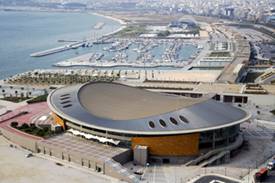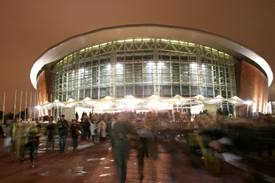For Immediate Release
Contact: Brigid Brown, Publicist
Cell) 551.358.1058
brigidbrown13@yahoo.com
|
The network of websites that comprise Chicago Art Map and Chicago Art Magazine are not simply local websites but a case study for a new model of online publishing.
See: http://chicagoartmagazine.com/transparency-pages/
“Print media is in a mindset that online publishing is simply posting on a screen rather than printing on paper,” says Kathryn Born, founder of the CAM. “It’s rarely utilizing the internet’s capabilities to connecting the story ancillary data and deeper pools of information. It doesn’t harness the power of online distributions, which can categorize and deliver content to the audience — in the exact moment and form they wish to receive it.”
What does that have to do with Chicago Art Map? The network stands as a proof-of-concept of new publishing through several scenarios. The key example is that Chicago has 300 art venues and countless events every week. Comprehensive lists are ideal, but unwieldy.
The answer? Put all the information into a database instead of a list. Put a Google Map layer on top, add images, and code additional software tools so the events can be sorted and filtered.
The result? Search an art map by geographical range or exhibit type (a museum vs. a gallery or alternative art space) or type of art or type of event. Sort alphabetically or by neighborhood, location, specialty and filtered by date and geography.
For Chicago Art Magazine, footnotes are back in style using “hovering” tools, paragraphs of extra information expand with a click to instantly reveals more information (without refreshing the page). And images! Since ink is no longer a cost factor, they’re abundant, and expand to full size when clicked upon.
Chicago Art Magazine doesn’t publish monthly, it publishes twice a day. Each piece is pushed out to over 5,000 Facebook and Twitter followers.
It’s operational budget, for what would-be a 200 page magazine, is only $1,700 a month. Every dime goes to writers, editors and staff. No rent, no paper, no trucks. Suddenly, an advertising-based model that only requires $2000 per month to support freelancers and stay in the black, is attainable, often with sole-sponsorship deals that provide a blast of coverage for only a few sponsors each month.
“‘Advertorial; content is permissible, but only if it’s fully disclosed in every instance,” is the policy of the magazine, as they are supported with “sponsored posts” along with graphic advertisements.
Most unusual, yet still in accordance with the Open source (software) background that prepared Kathryn Born for the task, is the idea of freely sharing ideas so that others can build upon what was learned. A tab called “transparency” reveals everything from tech tricks, to philosophy and budgets. A weekly blog gets into even smaller details about editorial and survival
-MORE-
The site speaks to all tiers of art fans whether a seasoned collector or a newbie looking to go out on a Friday evening. This breadth of reviews is credited to the aptly named “Friday Night Army” which is a team of critics, released onto the city, with the mission to report back on what is seen and heard in their own voice. “The editorial goal is to write about art in a simple, lively way, using pictures, video and audio,” says Born. “Our belief is that writing about art can be a literary style that’s as colorful as the art we describe.”
Chicago Art Magazine ~ Reviews & Features
Chicago Art Map ~ One-Stop-Shop Gallery Finder
The Chicago Art Machine speaks to all tiers of art fans whether it is a collector on the prowl for the latest discovery or a newbie looking to branch out. This breadth can be credited to the aptly named “Friday Night Army” which is a team of critics, released onto the city, with the mission to report back on what is seen and heard in their own voice.
Some features are more mainstream like, “The Bath Haus of Gaga” and others more niche-y but still accessible such as, “A Crash of Critters at Fill in the Blank”. No matter what genre, each article is informative and as a whole the network feels like a mini-course in art history. After a short time of perusing the sites, visitors will walk away knowing way more than when they started.
“The editorial goal is to write about art in a simple, lively way with a whole bunch of pictures, video and audio,” says Born. “The belief is that writing about art can be a literary style that’s as colorful as the art we describe.”
Kathryn Born is the Editor-in-Chief of the online Chicago Art Magazine and oversees ChicagoArtMap.com. Born breaking off to start her own network of sites, Born had created the blog Art Talk Chicago for the Chicago Tribune-sponsored network of blogs called ChicagoNow.com.
If you plan to run a review and/or would like to set up an interview with Kathryn Born, please contact: Brigid Brown @ 551.358.1058 or brigidbrown13@yahoo.com
Visit us online at: www.chicagoartmagazine.com
-END-
Filed under: art, art buyers, art fair, art galleries, art review | Tagged: art, art magazine, art news, art review, artist, chicago | 1 Comment »














 **Nicholas Forrest is an art market analyst, art critic and journalist based in Sydney, Australia. He is the founder of
**Nicholas Forrest is an art market analyst, art critic and journalist based in Sydney, Australia. He is the founder of 







 Let’s face it, art auctions are mainly about two things – money and excitement. Best suited to those buyers who don’t care what they buy as long as it is a potentially profitable bargain, art auctions are far more beneficial to the investor than to the collector. Auctions are not really suited to collectors at all because a collector usually looking for specific works which means that they don’t have the option of bidding on a different work or a work by another artist if the one they are after goes beyond their budget. Although a bargain may be picked up by a collector, the likelihood of the next work they want to purchase exceeding the estimate is just as likely. What this means is that if the collector is willing to pay what ever it takes to acquire a work for their collection, the bargains that they may have acquired at other auctions could effectively be canceled out. In the end it would probably have been far better for the collector to have purchased from a gallery where the prices are relatively stable and the pressure involved in making a purchase is far less.
Let’s face it, art auctions are mainly about two things – money and excitement. Best suited to those buyers who don’t care what they buy as long as it is a potentially profitable bargain, art auctions are far more beneficial to the investor than to the collector. Auctions are not really suited to collectors at all because a collector usually looking for specific works which means that they don’t have the option of bidding on a different work or a work by another artist if the one they are after goes beyond their budget. Although a bargain may be picked up by a collector, the likelihood of the next work they want to purchase exceeding the estimate is just as likely. What this means is that if the collector is willing to pay what ever it takes to acquire a work for their collection, the bargains that they may have acquired at other auctions could effectively be canceled out. In the end it would probably have been far better for the collector to have purchased from a gallery where the prices are relatively stable and the pressure involved in making a purchase is far less.


















